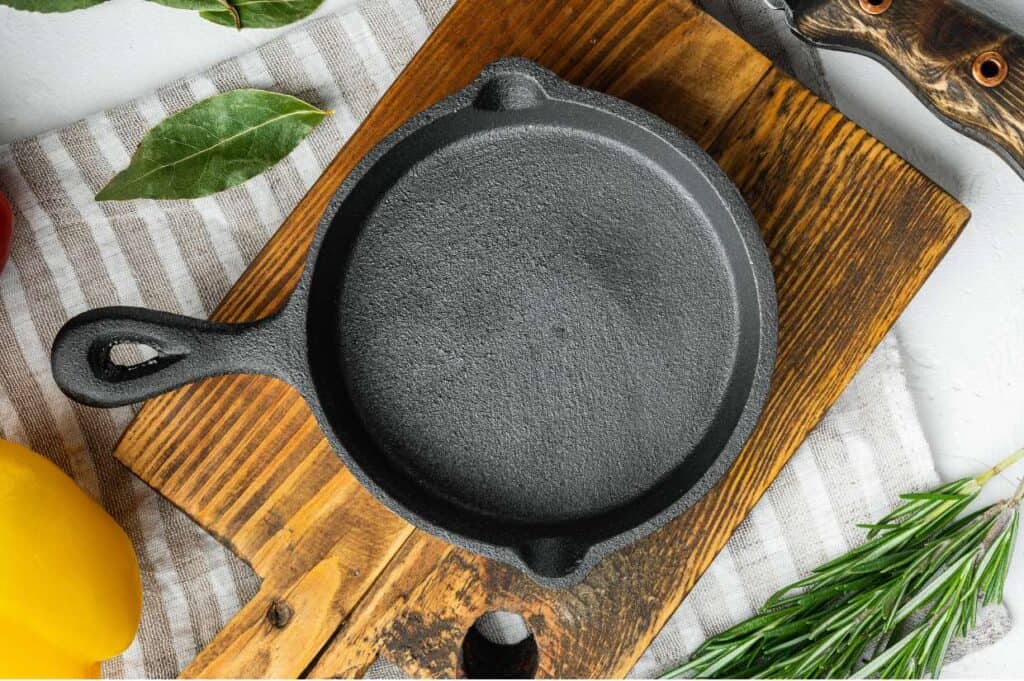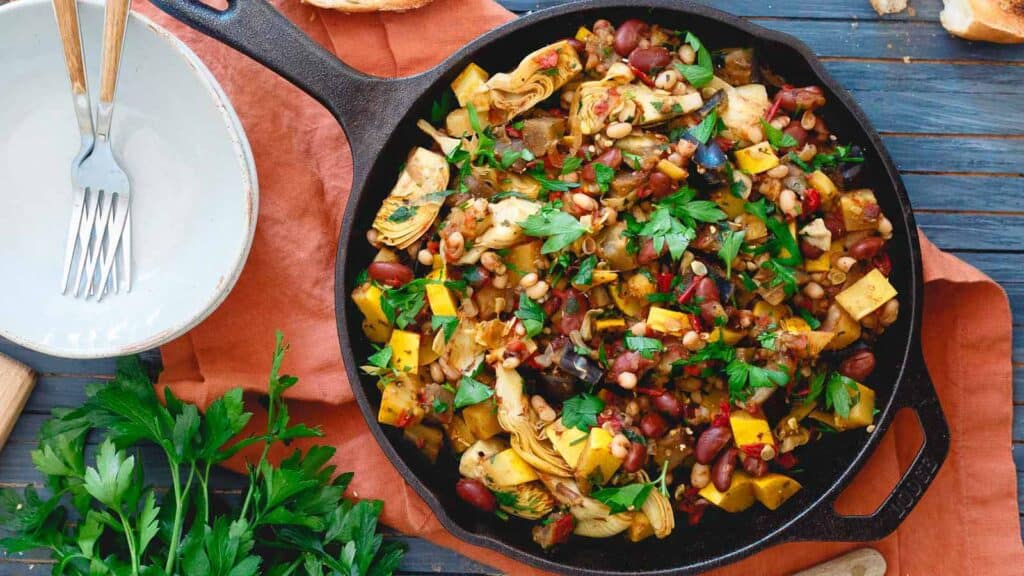Don’t be afraid of damaging a cast iron skillet and let that prevent you from using such a timeless kitchen accessory. Use these expert tips about how to clean a cast iron skillet, so you can cook confidently and treat your skillet like a pro.

How to clean a cast iron skillet in 3 easy steps
Cleaning cast iron is an easy three-step process, but you do need the proper technique and tools lest your beautiful pans incur any damage.
Treat it right and your skillet will last a lifetime and likely be in good enough condition to pass on to the next generation. That’s how tough this kitchen equipment is. Cast iron’s durability, longevity, and plastic-free nature make it a sustainable choice worth considering.
Unlike any other cookware, cast iron can get better with age. It also holds a nice, even heat, making an excellent tool for quick and easy skillet dinner meals.
“Cleaning a cast-iron skillet is not as scary as it seems. If the skillet is properly seasoned, there’s not much you can do in normal cleaning that will ruin the seasoning since the seasoning oil actually bonds with the metal to form a seal. Even dish soap can’t break through that bond.”
— Robin Donovan, All Ways Delicious
However, cast iron isn’t indestructible. For example, it’s not dishwasher safe, nor is it scratch-proof, and it will rust if not attended to correctly.

Step 1: Wash the skillet
When it comes to cleaning cast iron skillets, hot water is the go-to resource for getting the job done.
Begin by cleaning the pan out as best you can with a wooden or silicon spatula, and save leftovers in food-safe containers.
Next, place the pan under hot water and rinse off as much remaining food as possible.
You can also pre-wipe the pan, as Lara describes:
“After using a cast iron skillet, I like to let it cool down a bit and then wipe out the bits of food and grease with a paper towel or damp cloth.”
— Lara Clevenger, LaraClevenger.com
Then, hold a scouring pad or cleaning brush specifically for cast iron and gently scrub the surface as needed.
Typically, you only need to scrub for a minute or so before the pan returns to a spotless state.
Is it ok to use soap on cast iron?
A controversial atmosphere surrounding using soap on cast iron gets heated on both sides. Some say yes, while others say no.
America’s Test Kitchen sets the record straight by announcing: Yes, you can use soap on cast iron.
That being said, the statement assumes you’re working on a well-seasoned pan and choosing a mild dish soap.
Chances are, if you’re using a new pre-seasoned pan or have built up a good seasoning yourself, then it’s safe to wash gently with a mild dish cleaning agent.
More often than not, using hot water and a small amount of dish soap combined with a soft sponge is sufficient.
Step 2: Dry the skillet
Drying the skillet is the primary way we preserve long-term quality and keep it free from rust.
Set the pan over medium-high heat until the water evaporates off the surface.
Step 3: Season the skillet
Finally, rub oil over all surfaces, inside and out.
The process is as simple as it sounds:
“After I wipe the skillet dry with a dish towel, I put it on the stove over medium heat. Then, once it’s totally dry, I pour a little cooking oil in, and wipe that around the skillet with some paper towels. I can have cast iron cleaned and put away in less than 5 minutes!”
— Sara Nelson, Real Balanced
This seasoning method effectively creates a bond with the iron, thereby creating a natural nonstick coating that is so closely associated with cast iron cookware. It’s precisely this nonstick coating without chemicals that we’re after because cast iron cooking is great for just about anything from cabbage stir-fry to fish and even eggs.
The pan will be exceptionally hot after drying it out. Choose any cooking fat from lard or tallow to olive or flaxseed oil and wipe it around with a paper towel.
What to do with frightfully grimy pans?
You might be tempted to soak the pan in water as a way of softening up crusted and stuck-on food bits. Even though this works with regular dishes, please don’t make it a practice with your cast iron.
Instead, add water to the pan and heat it on the stovetop. Scrape the bottom and sides with a wooden spatula and continue heating until the water boils. Don’t risk scratching the coating with metal utensils.
Gina Matsoukas, from Running To The Kitchen, recommends making a paste with water and salt if the problem persists. Apply the salt scrub to the pan’s surface and spot clean with a folded kitchen towel or washcloth.
For seriously crusted skillets, spread 1 cup of salt on a still-warm pan. Then, likewise, fold a towel and scour the trouble zones. Finish off with a final rinse, and dry and season like normal.

Long-term care for cast iron skillets
Best practices indicate high-success rates by reseasoning a skillet often after use. Ideally, after each time you cook with it.
Avoid a gummy pan by maintaining a nice slick seasoning. Too much oil will build up into a sticky surface. If this ever happens, wash it off with hot water, dry thoroughly, and reseason with a thin layer of oil.
Be consistent by following the simple steps of washing, drying, and seasoning a cast iron skillet, and you’ll love having a clean and reliable piece of cooking equipment for all your one-pan meals and culinary needs.
Jessica Haggard is a lifelong recipe lover, blogger, and author of multiple cookbooks. She helps people find success with gluten-free, low-carb, and keto cooking at Primal Edge Health. While her second blog, Easy Homemade Life, is dedicated to dishing up super simple, family-friendly recipes along with DIY beauty care and natural homemaking tips.
I accidentally over dried the pan and black shiny crust appeared on the surface. I scoured the surface with a metal spatula and the surface now has blotches. Did I ruined my cast iron skillet? Is there a way to fix it. Desperately, Elsie
Rest assured you did not ruin the skillet by heating it, or by scraping it with a metal spatula.
Simply re-season it, and continue using and seasoning as normal. Any coating you might have scraped off will develop again fairly quickly with normal use.
And next time you think you’ve overheated your pan (which in my experience is very nearly impossible to do without putting it in your oven on the cleaning cycle), just wipe it down with paper towels to remove any oil residue that hasn’t yet bonded with the pan.
Don’t worry Elsie. As Peter says, not all is lost! It sounds like you removed the seasoning but have not ruined your pan. Re-season it and use it often so it builds up the coating again. Soon it will be as good as new. Then, clean gently, just as is outlined here in the post. You can do it!
Definitely not, based on what you said I would just srape off buildup, and season again. The only way to ruin cast iron is to put it in the dishwasher or shatter it. Just keep working on that seasoning.
Love these instructions
Thanks for the feedback Marie. I’m so glad they are helpful! An easy 1-2-3 process is all you need.